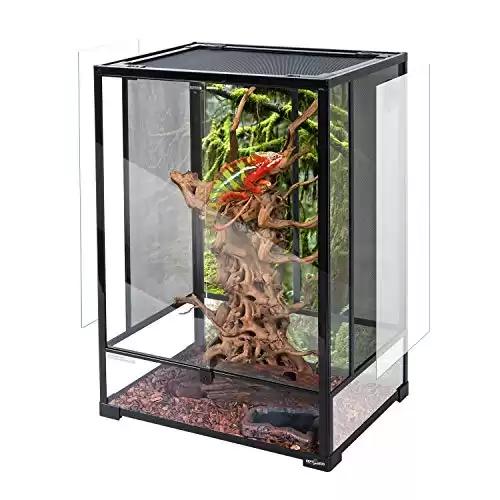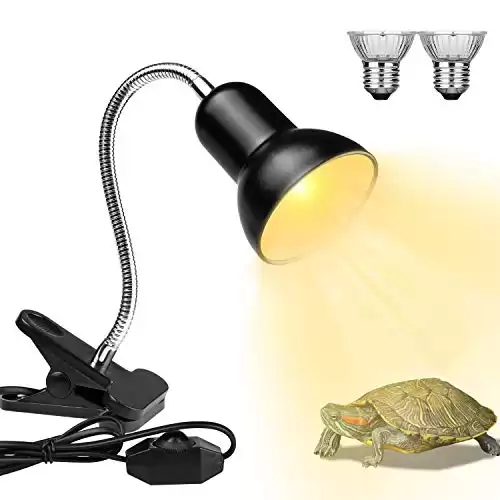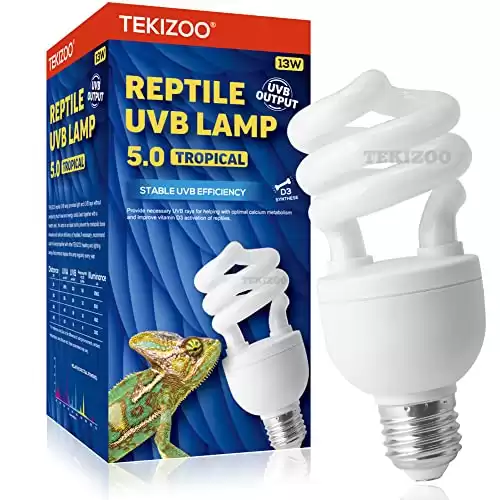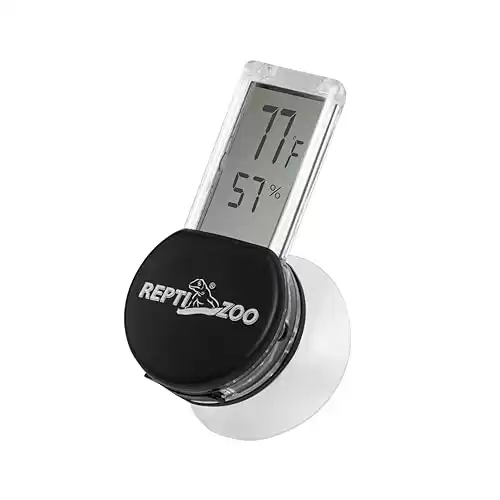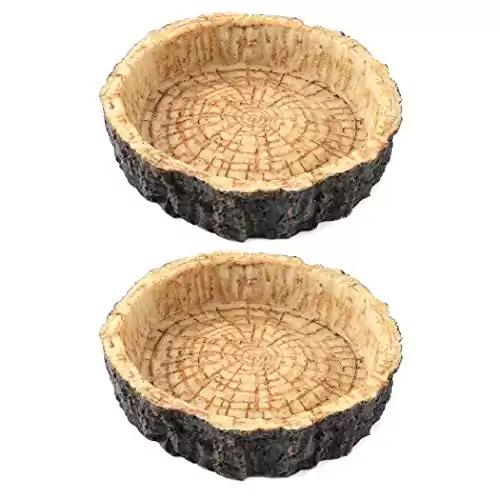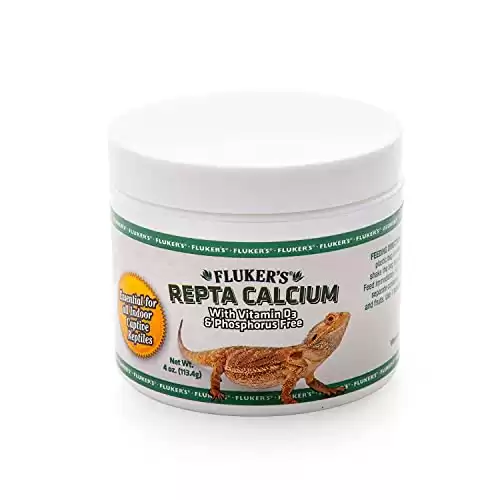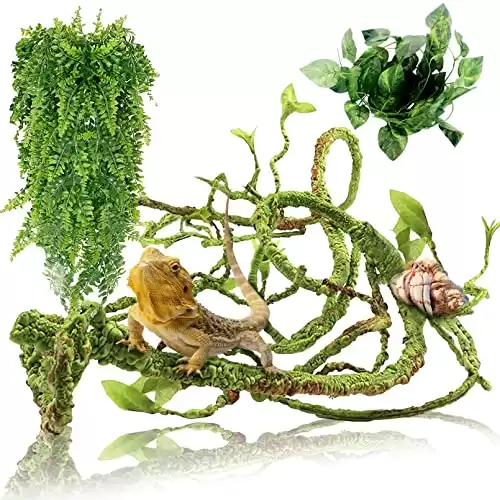Veiled chameleons, scientifically known as Chamaeleo calyptratus, are one of the most captivating and enigmatic creatures in the reptile kingdom.
Their vibrant colors, remarkable adaptations, and intriguing behaviors make them a subject of fascination for both seasoned herpetologists and casual animal enthusiasts alike.
In this article, we will delve into the world of veiled chameleons, exploring their habitat, physical characteristics, behavior, and care requirements.
How Do Veiled Chameleons Look?
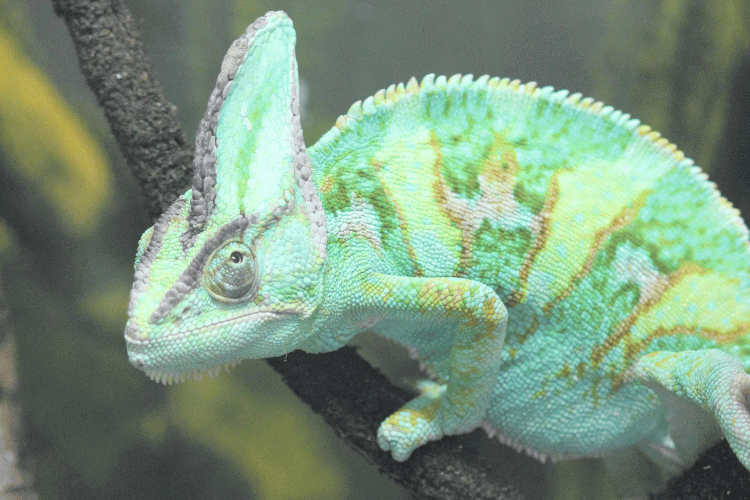
Veiled chameleons, with their captivating appearance, have some distinct physical features that set them apart. These unique characteristics make them a favorite among us, reptile parents.
One of the most noticeable features of these friendly reptiles is the casques on the top of their heads. These casques are bony protrusions that resemble shark fins and serve a practical function – helping the chameleons collect water.
Additionally, these chameleons have a fascinating line of fringe that starts beneath their mouths and extends down their bodies, adding to their distinctive appearance and aiding in camouflage.
These reptiles are known for their vibrant colors and striking markings as well. While their base coloration is green, their bodies are adorned with colorful markings that can vary.
Some of these markings include shades of black, green, orange, turquoise, and yellow, creating a visually captivating spectacle.
Another intriguing aspect of these cheeky chameleons is their sexual dimorphism, which means that males and females exhibit distinct physical differences.
What Do Male Veiled Chameleons Look Like?
Males of this species are the larger of the two sexes, typically reaching lengths between 17–24 inches. They boast a larger casque on their heads and have a more slender physique.
Their bodies are adorned with bright and eye-catching markings, featuring a kaleidoscope of colors, including black, green, orange, turquoise, and yellow.
What Do Female Veiled Chameleons Look Like?
In contrast, females are shorter in length, measuring approximately 10–14 inches, but they have a heavier-set build.
Their casques are smaller compared to their male counterparts. Females exhibit mottled markings in various shades, including orange, tan, white, and yellow.
Where Do Veiled Chameleons Live?
Veiled chameleons are native to the picturesque border region between Saudi Arabia and Yemen. They can be found inhabiting a variety of environments. These include lush forests, high plateaus, and meandering valleys.
This diversity of habitat speaks to their adaptability and ability to thrive in different surroundings.
Their natural habitat experiences temperature extremes as well, especially during the daytime. It’s not uncommon for temperatures to soar to scorching highs of up to 95°F (35°C) or even more during the hotter months.
However, these reptiles are also well-equipped to handle cooler nights, with temperatures dropping to around 65°F (18°C) or lower.
And given the arid climate of their native region, humidity levels are generally low.
Our chameleons have since evolved to efficiently conserve water, which allows them to go for extended periods without drinking. They obtain a significant portion of their hydration from their diet of plant matter and insects.
That doesn’t mean don’t keep a source of water laying around! Your pet lizard will still need to stay hydrated.
It’s also common to spot them perched on rocks or fence posts, soaking up the sun’s rays. This behavior aligns perfectly with their need for basking and maintaining optimal body temperature.
What Is the Ideal Captive Habitat for Veiled Chameleons?
When it comes to providing the best home for your pet chameleon, it’s essential to mimic their natural habitat while prioritizing their comfort and well-being.
For starters, unlike glass enclosures, screened habitats are recommended for veiled chameleons. These screens offer excellent ventilation, preventing the buildup of moisture and mold. Adequate airflow is crucial for maintaining a healthy environment after all.
To recreate their natural habitat, establish a temperature gradient within the enclosure as well. One side should have a warm basking area with a
The opposite side should be cooler, with temperatures ranging from 75°F to 85°F (24°C to 29°C). This temperature variation allows them to regulate their body temperature effectively.
Additionally, veiled chameleons love to climb, so include branches, ledges, and climbing opportunities to mimic their natural behavior. These elements also help keep them mentally stimulated. Your reptiles will also need plenty of hiding spots.
What Is the Ideal Enclosure for Young Veiled Chameleons?
For juvenile veiled chameleons, a spacious habitat is key. Aim for dimensions of at least 2 feet in each direction, such as 24 inches in length, width, and height.
These young chameleons are natural climbers, so a taller enclosure rather than a wide one allows them space to exercise and explore.
What Is the Ideal Enclosure for Adult Veiled Chameleons?
Adult veiled chameleons require even more space to thrive. Ideally, their habitat should have dimensions of 3 feet or more in every direction, creating a comfortable space that measures 36 inches in length, width, and height.
What Are the Ideal Tank Mates for Veiled Chameleons?
Veiled chameleons are solitary creatures in the wild. They prefer having their own space and can become territorial and even aggressive when kept in pairs or groups.
Introducing another chameleon of their species, especially of the same sex, can lead to clashes and stress for both individuals.
Mixing different species can also result in conflicts, with potentially harmful consequences for your chameleon or the other animals.
What Are the Feeding Habits of Veiled Chameleons?
Young veiled chameleons have specific dietary needs. Their diet should consist of a balanced mix of live prey and plant matter. As they are still growing, they require more animal protein for development.
This means feeding them a variety of gut-loaded insects, such as crickets, grasshoppers, mealworms, roaches, locusts, wax worms, and silkworms. These insects should be appropriately sized, ideally no larger than the width of the chameleon’s head.
As your baby reptile matures into adulthood, their dietary requirements change. While they still need insects in their diet, the ratio of animal protein to plant matter should shift towards more greens.
Leafy greens like collard greens, mustard greens, and dandelion greens are excellent choices to provide essential nutrients.
Supplements play a vital role in their diet too. To prevent Metabolic Bone Disease, it’s crucial to dust their insect prey with
What Is the Temperament of Veiled Chameleons?
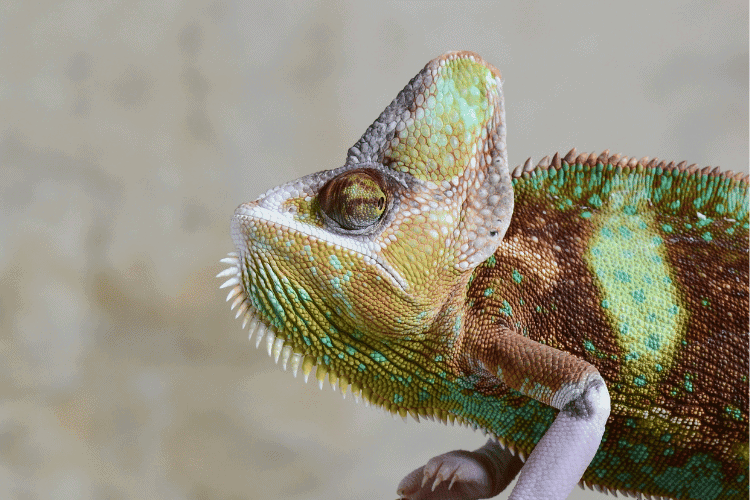
These solitary chameleons are unique in that they tend to find regular handling stressful. They are more suited to being observed rather than frequently held.
That said, they can learn to tolerate handling, especially when properly acclimated and treated with care. As such, they become rather docile towards their human friends.
However, it’s important to note that this courtesy doesn’t extend to fellow chameleons as they can be quite aggressive towards those of their species.
Like any pet though, veiled chameleons can have individual personalities. Some may be more outgoing and curious, while others might be a tad more reserved.
Patience and understanding their unique quirks can help build a deeper bond with your pet reptile.
What Are the Common Health Issues for Veiled Chameleons?
As loving caretakers of these remarkable reptiles, it’s crucial to be aware of potential health concerns and how to spot them early for prompt treatment.
- Parasitic Infestations: Veiled chameleons, like other chameleon species, are susceptible to parasitic infestations. Symptoms may include weight loss, reduced appetite, and lethargy. Regular fecal tests are essential to detect and treat parasites promptly.
- Kidney Failure: Kidney failure can occur in these chameleons and may manifest as increased urination, drinking excessively, or swelling around the throat area. Maintaining proper hydration levels and a clean enclosure can help prevent kidney issues.
- Metabolic Bone Disease (MBD): Metabolic Bone Disease is a common concern, particularly when veiled chameleons lack proper
calcium intake. Symptoms include deformities, weak bones, and difficulty moving. Ensure your chameleon receives a balanced diet withcalcium supplementation to prevent MBD. - Respiratory Infections: Respiratory infections can affect chameleons due to incorrect temperature and humidity levels. Signs may include wheezing, nasal discharge, or labored breathing. Maintaining optimal environmental conditions is crucial.
- Stress-Related Diseases: Stress can lead to various health problems in chameleons, impacting their overall well-being. Reducing stressors, such as excessive handling or changes in their environment, is essential. Create a peaceful, consistent habitat to minimize stress-related issues.
What Are the Lifespan and Size of Veiled Chameleons?
Veiled chameleons typically have a lifespan of about 4 to 8 years in captivity. However, it’s important to note that females tend to live around five years, while males can have a slightly longer lifespan of about eight years.
Proper care, including a suitable habitat, nutrition, and stress reduction, can contribute to a longer and healthier life for your pet chameleon.
Further, these chameleons undergo significant growth as they progress through various life stages.
Males are generally larger, reaching lengths of up to 24 inches, although the average falls between 14 to 18 inches. Females, on the other hand, are smaller, with an average length of just under 12 inches.
What Are the Breeding Habits of Veiled Chameleons?
Unlike some reptiles that require a period of cooling to induce the reproductive cycle, veiled chameleons are quite different.
They breed readily and do not necessitate a cooling-off period. This means that they can potentially breed throughout the year without specific seasonal triggers. That said, they’re more likely to breed during the spring and summer months when conditions are more favorable.
Females possess remarkable fertility as well. They are capable of producing a substantial number of eggs, ranging from approximately 45 to 90 eggs or even more in a single reproductive cycle.
What’s even more fascinating is that they can repeat this process multiple times per year!
Due to their prolific breeding behavior, it’s also relatively easy to maintain a productive breeding colony of these special chameleons—but this applies to experienced breeders more than beginner ones.
For successful breeding, it’s essential to provide a suitable environment that mimics their natural habitat, including the right temperature, humidity, and ample hiding spots. Additionally, ensuring a well-balanced diet for both males and females is just as crucial.
Are There Legal Considerations for Owning a Veiled Chameleon?
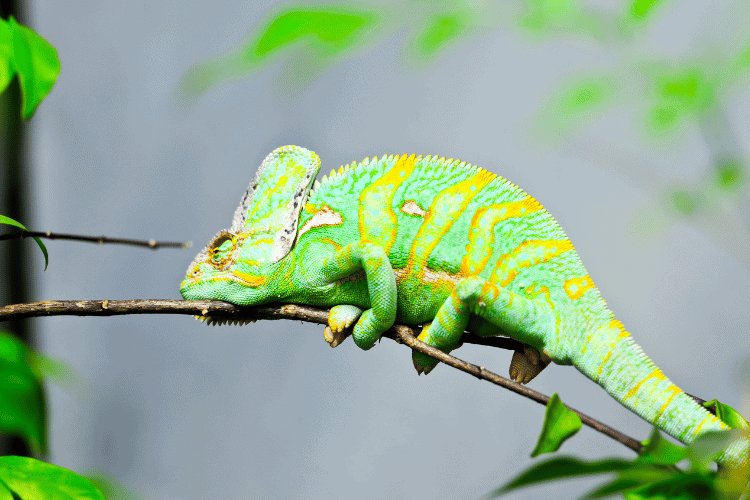
When it comes to keeping veiled chameleons as pets, it’s essential to be aware of any legal requirements or restrictions that may apply in your region or jurisdiction.
Many chameleons, including veiled chameleons, fall under the category of protected species. This means that owning one as a pet may require a permit. These permits are typically obtained through programs like the Convention on International Trade in Endangered Species (CITES).
Under the CITES program, it is legal to trade chameleons, but there are strict regulations in place to ensure their conservation. It’s illegal to take veiled chameleons from the wild, for instance.
Therefore, if you wish to own a veiled chameleon, it’s crucial to obtain the necessary permits and adhere to the legal guidelines to ensure their well-being and the preservation of these captivating reptiles.
Additional Resources
- Books:
- “Veiled Chameleon Owner’s Manual” by Jonathan Durham
- “Veiled Chameleon Care Made Easy” by Mitchell T. Cudmore
- “Chameleons: Care and Breeding of Jackson’s, Panther, Veiled, and Parson’s” by Gary Ferguson, Kenneth Kalisch, Sean McKeown
- Forums:
- OurReptileForum.com
- Chameleonforums.com
Case Study
Scroll through pictures of the cheeky Lenny the Veiled Chameleon (@lennythechameleon) who finds comfort in hiding both in her enclosure and in her companion’s arms! She’s almost like a cat.
FAQs
Are veiled chameleons hard to take care of?
Veiled chameleons can be rewarding pets with proper care. Their specific needs, including temperature, humidity, and diet, require attention, but they can thrive when their habitat mimics their natural environment.
What do veiled chameleons need?
Your chameleon needs a spacious enclosure, suitable temperature and humidity levels, UVB lighting, a variety of insects, and a clean habitat. Providing them with a well-balanced diet and minimizing stressors contributes to their well-being.
Do veiled chameleons need darkness?
Yes, veiled chameleons need a period of darkness at night to simulate their natural day-night cycle. Providing them with a consistent light-dark schedule helps maintain their health and reduces stress.
Equipment Needed
- Screened enclosure
- Heat Lamp
- UVB Lamp
- Thermometer
- Hygrometer
- Food and Water Dishes
- Substrate (paper towels or old newspapers are ideal)
- Branches and Climbing Perches
- Calcium and Multivitamin Supplements
- Feeding Tongs

